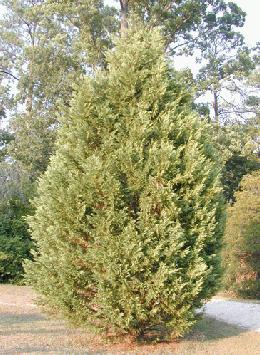Source(s): Stephen D Pettis
Leyland cypress (Cupressocyparis leylandii) is one of the most commonly used landscape trees in Gwinnett County today. The tree has many fine attributes such as rapid growth, easy propagation, and inexpensiveness. It is a terrific plant for screening due to its rapid growth. Unfortunately, due to poor planning, we are starting to see some serious problems associated with this popular plant. It seems we just plant them too close together.
Leylands have traditionally been pest resistant, owing much of their popularity to this fact. This is changing now due to overuse of the plant, poor sighting and spacing, and the emergence of some lethal fungal infections. There are many disease problems plaguing Leylands today. Because they are often planted too close together, Leyland Cypress is prone to several damaging canker diseases, root rot and other pests. Prolonged drought and other stresses exacerbate disease susceptibility as well.
In Georgia, cankers are probably the most important and destructive diseases of Leyland cypress in the landscape. Cankers are the tree equivalent of human sores; exposed, infected tissue that exudes infectious liquid. Two examples of damaging canker diseases are Seiridium canker and Botryosphaeria (Bot) dieback.
Seiridium canker tends to appear as tip dieback whereas Bot canker tends to appear as branch dieback. Seiridium causes numerous thin, elongated cankers on stems, branches and branch axils. These cankers cause twig and eventually branch dieback. Bot causes sunken, girdling cankers at the base of the dead shoot or branch. Sometimes, the main trunk shows cankers that might extend for a foot or more in length. These cankers rarely girdle the trunk but will kill branches that may be encompassed by the canker as it grows.
Proper establishment and care are the best defenses against canker diseases in residential and commercial landscapes. Due to the endemic nature of these fungi and the size of many Leylands, spraying is not an option. Proper siting and sanitation are the best controls for canker diseases. Plant Leylands at least 12’ apart to avoid overcrowding and reduction of air flow through the canopy of the trees. Try to avoid planting the tree in shady areas where leaf dampness may persist. If a planting or rows of trees have begun to grow into one another, consider taking out every other tree. Sanitation, such as removal of cankered twigs and branches, helps prevent disease spread. Destroy pruned materials, and disinfect pruning tools by rinsing in rubbing alcohol or a solution of 1 part bleach to 9 parts water. Remove extensively damaged trees or trees that are damaged in the main trunk.
Due to its relatively poorly developed root system, plant Leyland Cypress in well-drained soils to encourage plant vigor. Remember, these trees hate ‘wet feet’. To minimize water loss and water competition with other plant species such as turf, mulch an area several feet beyond the lowest limbs. During hot, dry summer days, irrigate trees thoroughly around the base of the tree every 7-14 days, depending on soil composition. Take special care of trees located near driveways, paved areas or heat-reflecting buildings by providing adequate irrigation during periods of drought. Avoiding excessive watering and heat stress is vital to establishment of a healthy, disease resistant Leyland Cypress.
Center Publication Number: 113
- Herbicide Damaged Plants - September 24, 2013
- IPM in the Garden - September 24, 2013
- Leylands Get Really Big - September 24, 2013
